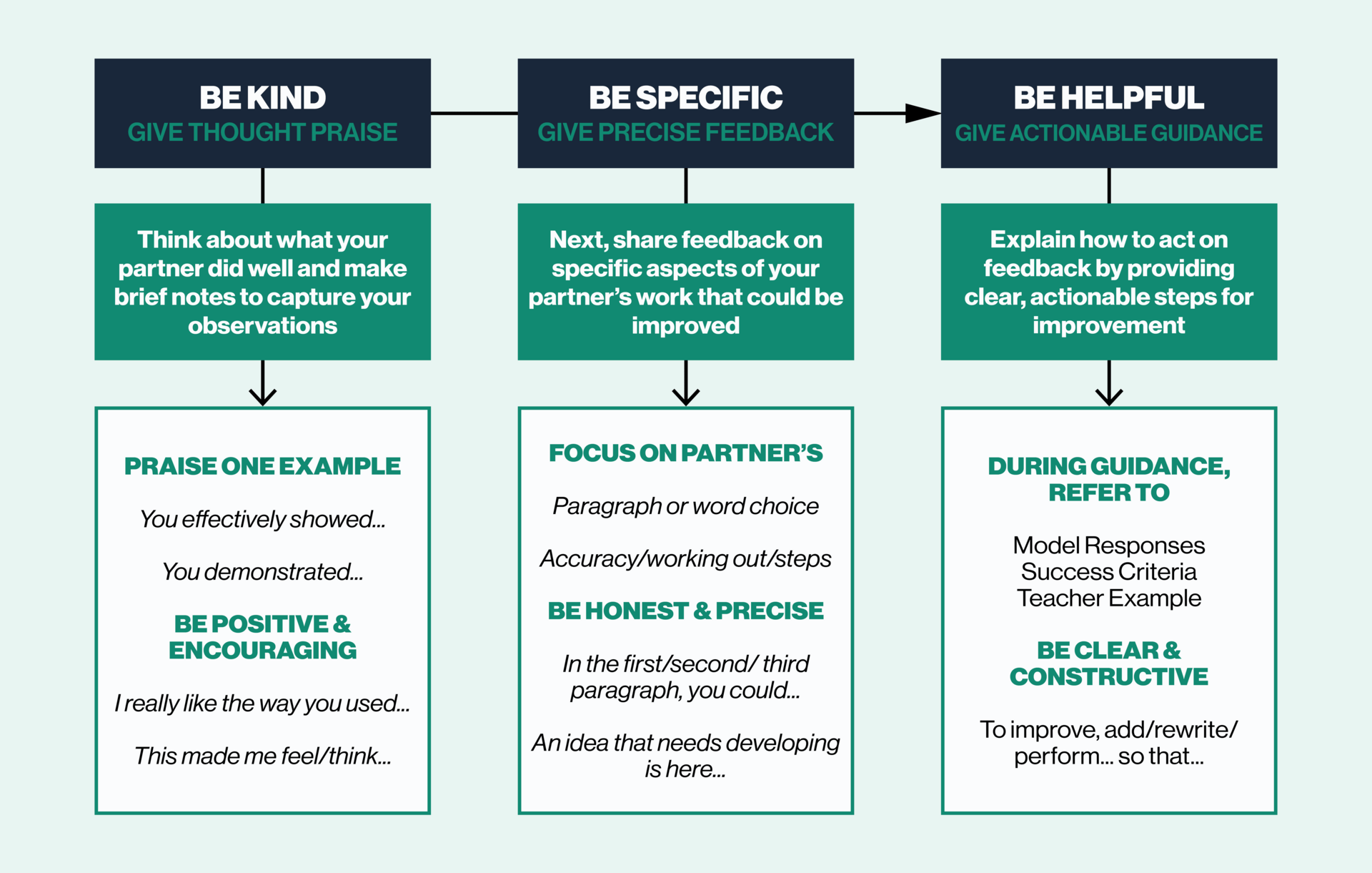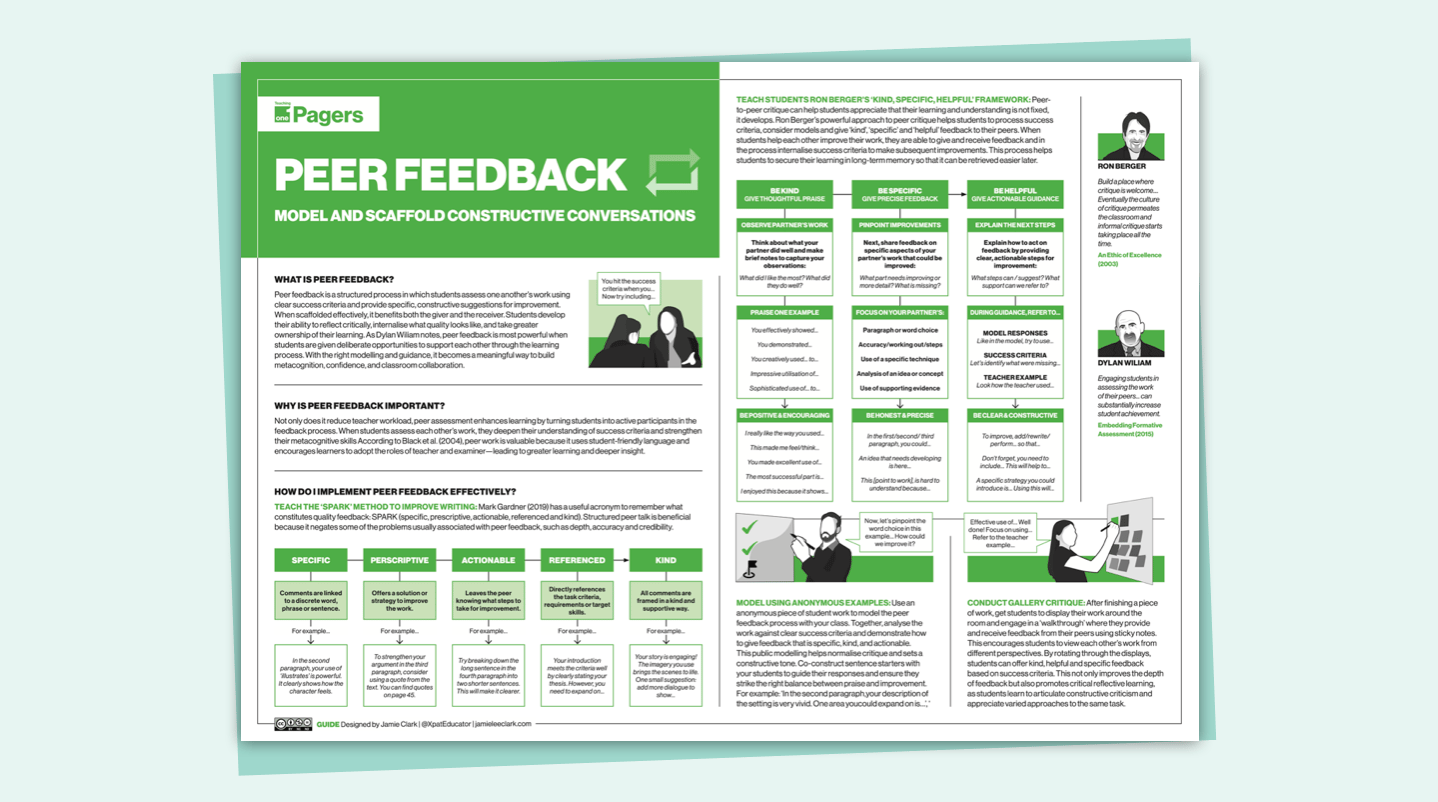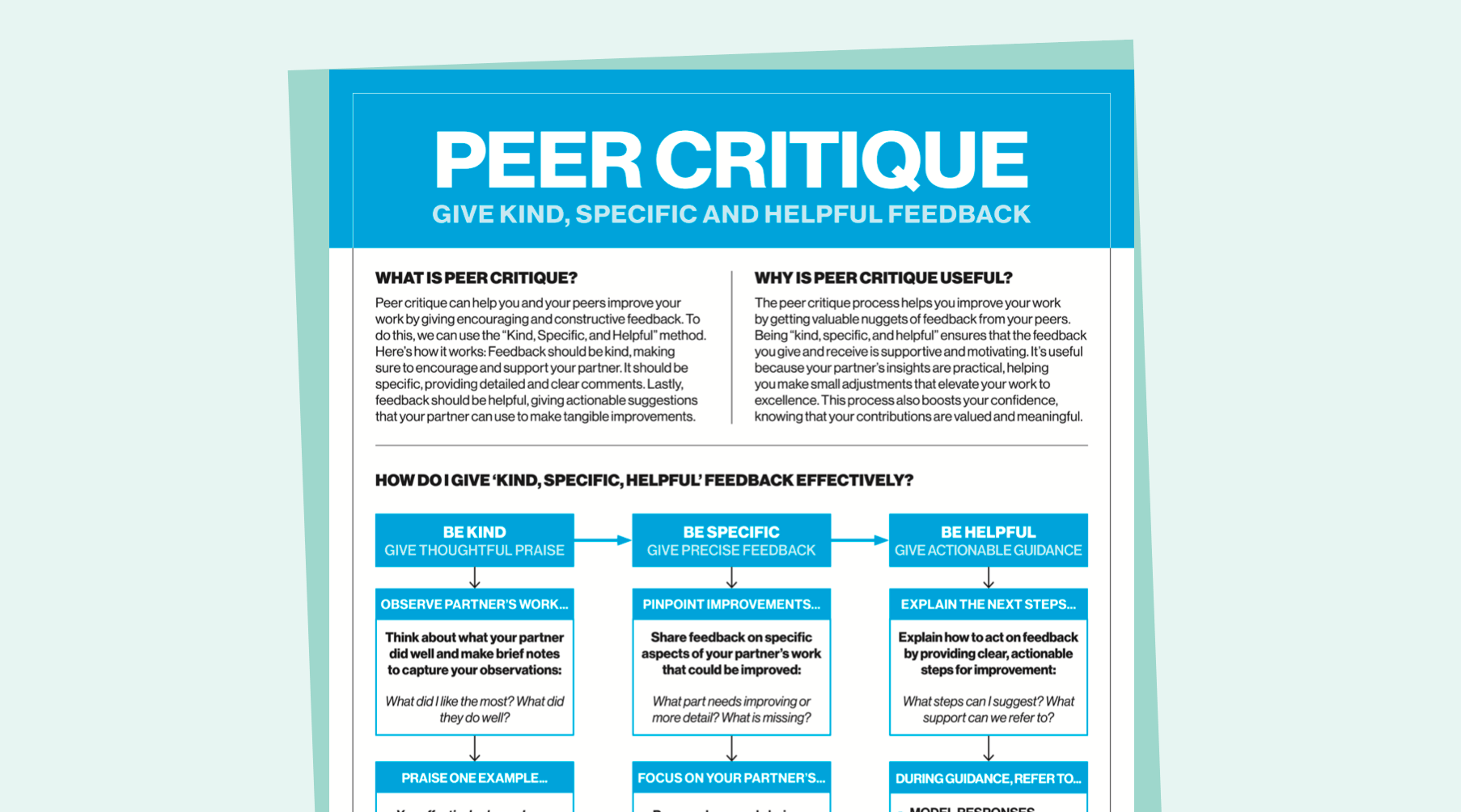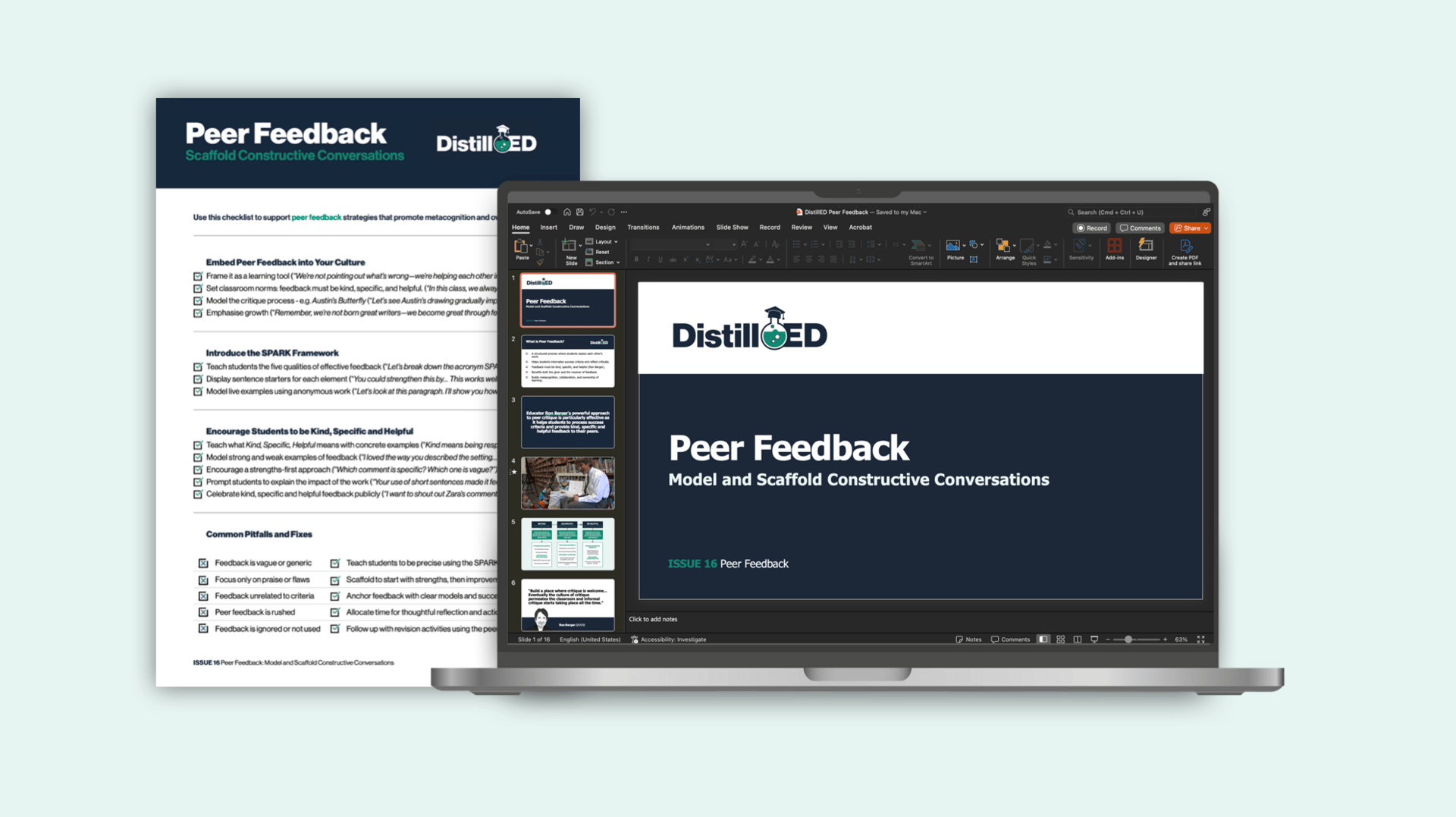👋 Hello {{first name | friend!}}
In this edition of ⚗️DistillED, we’re turning the spotlight on peer feedback—a powerful strategy that transforms students from passive recipients into active critics, collaborators, and co-creators of learning.

What is peer feedback?
Peer feedback is a structured process where students assess each other’s work using clear success criteria and give clear actionable steps for them to improve.
Educator Ron Berger's powerful approach to peer critique is particularly effective as it helps students to process success criteria and provide kind, specific and helpful feedback to their peers.

Download the high-quality student scaffold at the end of this post.
According to Berger, effective feedback is not about pointing out flaws but about helping eachother improve and strive for higher quality work. Through the critique process, students learn to appreciate sustained effort and making iterative adjustments of improvement. In other words, understanding is not fixed, it develops. Berger says this is central to building a classroom culture of excellence:
“Build a place where critique is welcome... Eventually the culture of critique permeates the classroom and informal critique starts taking place all the time.”
If you haven’t yet seen Ron Berger’s famous Austin’s Butterfly video, you’ll find it in the thread below—along with a free one-page guide summarising key ideas from An Ethic of Excellence.
Why is peer feedback effective?
When done well, peer feedback builds a supportive classroom environment where students learn to value feedback as a tool for growth.
Develops Metacognition: As students evaluate each other’s work, they reflect on their own thinking and refine their understanding.
Deepens Understanding of Success Criteria: Giving feedback requires students to internalise what ‘good’ looks like.
Encourages Ownership: Students take greater responsibility for their learning and begin to see themselves as capable of improvement.
Reduces Teacher Workload: Feedback doesn’t always need to come from the teacher—structured peer critique can be just as effective.
Boosts Achievement: Peer assessment has been shown to significantly improve student outcomes (Wiliam, 2015).
Fosters Collaboration: A classroom culture grounded in respectful, constructive critique promotes shared learning and growth (Berger, 2003).
Peer feedback is a powerful, two-way driver of learning. When students assess a classmate’s work using clear success criteria, they’re forced to apply those standards thoughtfully—sharpening their own understanding of what quality looks like. Because the work isn’t their own, it’s easier to offer honest, objective suggestions without the emotional weight of self-assessment.
“Engaging students in assessing the work of their peers... can substantially increase student achievement.”
Dylan Wiliam notes that the process helps the giver just as much as the receiver. Translating criteria into constructive feedback helps students internalise expectations, making their own future work stronger. As Wiliam puts it, peer assessment becomes “a stepping-stone to self-assessment”.
So, how do we build a classroom culture where feedback is kind, specific, and helpful? How do we ensure peer assessment becomes more than just box-ticking—and instead, a meaningful part of how students learn?
Let’s find out.
How do I implement peer feedback?
Kind, Specific, Helpful Critique
The free one-page resource at the end of this post scaffolds Ron Berger’s descriptive peer feedback approach. Scaffolding peer feedback activities can help make the process more supportive, motivating, and actionable for all students.
The SPARK Approach
Mark Gardner’s SPARK framework (2019) offers a clear, five-step guide to high-quality peer feedback: Specific, Prescriptive, Actionable, Referenced, and Kind. This structured approach helps address common challenges in peer assessment—such as lack of depth, accuracy, and credibility—by guiding students to give focused, thoughtful, and supportive feedback.
Step | Explanation | Example |
|---|---|---|
1. Specific
| Focus comments on a particular word, phrase, idea, or section to make feedback more meaningful. | “In the second paragraph, your use of ‘illustrates’ is powerful—it really shows how the character feels.” |
2. Prescriptive
| Suggest concrete ways to improve rather than vague praise or criticism. | “To strengthen your argument in the third paragraph, consider adding a direct quote from the text.” |
3. Actionable
| Leave your peer knowing exactly what they can do to revise or improve their work. | “Try breaking that long sentence into two shorter ones to improve clarity.” |
4. Referenced → Purpose: Link feedback to clear criteria or success standards | Connect comments to success criteria, task instructions, or modelled examples to add credibility. | “You’ve included a clear thesis, which meets the criteria. Next, try expanding on your second example.” |
5. Kind → Purpose: Maintain a supportive and constructive tone | Frame feedback respectfully, balancing praise with improvement to encourage a growth mindset. | “Your story is engaging! One idea: try adding more dialogue to bring the characters to life even more.” |
Remember, building a culture of peer feedback takes time. Resist the urge to perfect every comment yourself—let students do the work of critique. It might feel messy at first, but trust the process. When students learn to support one another with kind, specific, and actionable feedback, they don’t just improve their writing—they grow as learners.
Until next time — stay kind, stay constructive!
Jamie
Where can I find out more?
FREE One-Page Guide
To support your classroom wait times, I’ve put together a simple 10 and 5 second PowerPoint timer to help you rehearse and maximise thinking time with your students.


Checklist and Slideshow
This week’s ⚗️DistillED+ resources are a checklist and PowerPoint slideshow for teacher CPD. They include the WHAT, WHY and HOW of effective peer feedback.
Upgrade to ⚗️DistillED+ download the content.

Upgrade to DistillED+ to get this content!
Join DistillED+
Members gain access to expertly curated digital evidence-informed content
UPGRADEA ⚗️DistillED+ subscription gets you:
- Full access to new premium one-page guides
- Full access to evidence-informed strategy checklists
- Full access to slide templates (PowerPoint and Keynote)


